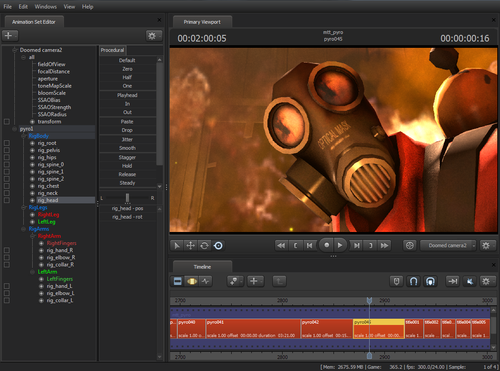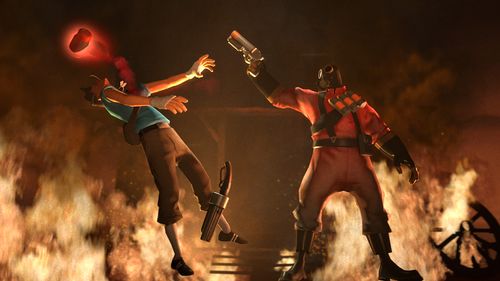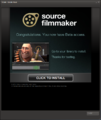Source Filmmaker
| “Oh dear, I've made quite a mess.” This page has been marked for general cleanup. Reason given: general reorganization, more info and simple focus Please see the Team Fortress Wiki style guide for information on how to improve this article. |
| “ | The Source Filmmaker is the movie-making tool built and used by Valve to make movies inside the Source game engine. It is how we have been making all of our animated short movies. Because the Source Filmmaker uses the same assets as a Source-engine game, what goes into the game can be used in the movie, and vice versa. By using the hardware rendering of a modern PC gaming machine, the SFM allows storytellers to work in a �what you see is what you get�(sic) environment so that they can iterate in the context of what it will feel like for the final audience.
— Source Filmmaker FAQ intro
|
” |
Source Filmmaker (SFM for short) is a program and tool used to create most of the videos running the Source Engine. Source Filmmaker is a video capture and editing application that works from inside the Source engine. It allows users to record themselves many times over in the same scene, creating the illusion of many participants, as well as supporting a wide range of cinematographic effects and techniques such as motion blur, Tyndall effects, dynamic lighting, and depth of field (motion blur has now been added to the games themselves, though only when the view is moving at high speeds – not per-object as in the filmmaker). Per-object motion blur is in the replay system of Team Fortress 2.
The tool was leaked in the original Team Fortress 2 Beta release. Following the discovery of the program's files inside Team Fortress 2 Beta, the community succeeded in creating a (mostly) stable version. Since then, many fan videos have been created with the tool. Valve officially released a closed beta version of the program on June 27, 2012, following the release of Meet the Pyro. On July 11th, the Source Filmmaker beta became public. The Source Filmmaker tool does not only allow you to record yourself in a scene over and over again but also allows the creation of pose to pose animations, posters and image sequences. There is also an audio editor below the timeline allowing the user to add audio files into their project such as music or lines from the Team Fortress 2 in-game characters, these are built in to the Source Filmmaker tool by default. Models, sounds, maps and a wide variety of custom content can be found on the Source Filmmaker Community Workshop.
Contents
Features
SFM allows you to:
- Record footage into:
- Uncompressed
AVIfiles TGAfiles- Frames of footage, user defined
- Single frame, or a "poster", similar to a Screenshot
WAVfiles of sounds- (All can be done simultaneously)
- Uncompressed
- Record yourself performing one part, then rewinding and record yourself performing another.
- Publish videos directly to Steam
- Publish videos to YouTube
- Control camera placement and movement
- Add per-object motion blur and depth of field
- Import choreography scenes
- Modify bone placement and facial expressions of characters
Public release
Source Filmmaker's public release was officially announced on June 27, 2012 as part of Day 3 of the Pyromania update[1]. A closed beta began on the same day, allowing select users who completed a survey access to the program. The initial release features an updated UI in comparison to the version of Source Filmmaker leaked years prior, and also allows users editing access to Meet the Heavy's assets. An open beta began on July 11, with Meet the Engineer assets added.
Official Valve productions
Valve has used Source Filmmaker for their own game trailers and short films, most significantly the Meet the Team series of videos, and the intro videos for Left 4 Dead and Left 4 Dead 2. It is mostly used when the film contains something outside of the game's capabilities, like new facial expressions and cinematic animations. Besides Team Fortress 2 videos, Valve has used Source Filmmaker with Left 4 Dead and Left 4 Dead 2, Day of Defeat: Source, Portal 2 as well as Half-Life 2 for announcing the game's arrival on the Macintosh.
Gallery
External links
- Source Filmmaker - Official Source Filmmaker Website.
- Source Filmmaker on the Valve Developer Community.
- Source Filmmaker community on Steam.
- Source Filmmaker is LIVE! - The official Source Filmmaker blog announcing the open beta.




